Enhancing-the-Taste-of-Our-Food
中西方饮食的对比英语作文
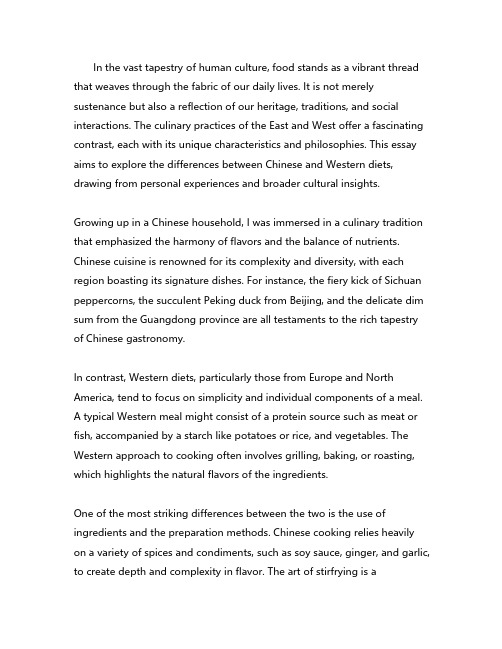
In the vast tapestry of human culture,food stands as a vibrant thread that weaves through the fabric of our daily lives.It is not merely sustenance but also a reflection of our heritage,traditions,and social interactions.The culinary practices of the East and West offer a fascinating contrast,each with its unique characteristics and philosophies.This essay aims to explore the differences between Chinese and Western diets, drawing from personal experiences and broader cultural insights.Growing up in a Chinese household,I was immersed in a culinary tradition that emphasized the harmony of flavors and the balance of nutrients. Chinese cuisine is renowned for its complexity and diversity,with each region boasting its signature dishes.For instance,the fiery kick of Sichuan peppercorns,the succulent Peking duck from Beijing,and the delicate dim sum from the Guangdong province are all testaments to the rich tapestry of Chinese gastronomy.In contrast,Western diets,particularly those from Europe and North America,tend to focus on simplicity and individual components of a meal.A typical Western meal might consist of a protein source such as meat or fish,accompanied by a starch like potatoes or rice,and vegetables.The Western approach to cooking often involves grilling,baking,or roasting, which highlights the natural flavors of the ingredients.One of the most striking differences between the two is the use of ingredients and the preparation methods.Chinese cooking relies heavily on a variety of spices and condiments,such as soy sauce,ginger,and garlic, to create depth and complexity in flavor.The art of stirfrying is aquintessential technique that allows for quick cooking while preserving the nutrients and flavors of the ingredients.On the other hand,Western cuisine often employs dairy products and butter,which impart a creamy texture and richness to dishes.The use of herbs like rosemary,thyme,and basil adds a distinct aroma and taste to Western dishes.Moreover,the practice of pairing food with wine in Western culture is a testament to the importance of enhancing the dining experience through complementary flavors.The dining experience itself is another area where East and West diverge. In Chinese culture,meals are often communal affairs,with multiple dishes shared among family and friends.This practice encourages social interaction and the enjoyment of a variety of flavors in one sitting.In contrast,Western meals tend to be more individualistic,with each person having their own plate and set of utensils.Furthermore,the concept of food as medicine is deeply ingrained in Chinese culture.Traditional Chinese medicine TCM often prescribes specific foods to balance ones bodys energy,or qi,and to prevent illnesses. This holistic approach to health and wellness is reflected in the Chinese diet,which emphasizes the consumption of whole,unprocessed foods and the avoidance of overly greasy or spicy dishes that may disrupt the bodys balance.In Western culture,while there is a growing awareness of the importance of a balanced diet,the focus is often more on individual nutritional needsrather than a collective approach to health.The rise of dietary trends and fads in the West,such as veganism and keto diets,reflects a more personalized approach to eating.In conclusion,the culinary traditions of the East and West offer a rich tapestry of flavors,techniques,and philosophies that enrich our global food culture.While Chinese cuisine emphasizes harmony,balance,and the use of spices,Western diets focus on simplicity,individual components, and the natural flavors of ingredients.The dining experience,use of ingredients,and approach to health and wellness all contribute to the unique characteristics of each culinary tradition.As we continue to share and learn from each others food practices,we can appreciate the diversity and depth of human culture through the universal language of food.。
科学课洋葱 英语阅读理解
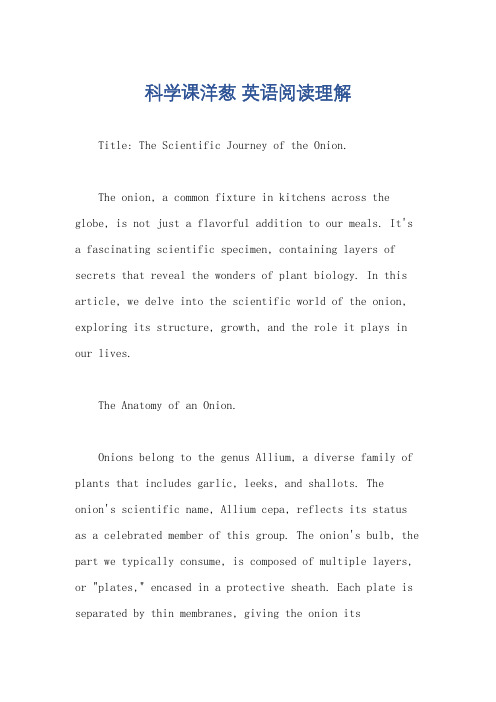
科学课洋葱英语阅读理解Title: The Scientific Journey of the Onion.The onion, a common fixture in kitchens across the globe, is not just a flavorful addition to our meals. It's a fascinating scientific specimen, containing layers of secrets that reveal the wonders of plant biology. In this article, we delve into the scientific world of the onion, exploring its structure, growth, and the role it plays in our lives.The Anatomy of an Onion.Onions belong to the genus Allium, a diverse family of plants that includes garlic, leeks, and shallots. Theonion's scientific name, Allium cepa, reflects its status as a celebrated member of this group. The onion's bulb, the part we typically consume, is composed of multiple layers, or "plates," encased in a protective sheath. Each plate is separated by thin membranes, giving the onion itscharacteristic layered appearance.Under the microscope, the onion's cells reveal their unique structure. The cells are arranged in a tight grid, with each cell containing a nucleus and other organelles. The cell walls, made of cellulose, provide structure and rigidity to the onion's layers.The Growth of an Onion.The onion's growth cycle begins with a small seed, which germinates under favorable conditions. As the seed sprouts, it forms a bulblet, the precursor to the bulb. As the plant grows, the bulblet enlarges, adding layers of cells to form the bulb's characteristic shape.The onion's growth is influenced by various factors, including soil type, water availability, and temperature. The plant prefers well-drained soil with a pH that is slightly acidic to neutral. Adequate water is essential for the onion to maintain its turgidity, or state of being plump and firm. Temperature also plays a crucial role, asonions require cool weather to develop their flavorful layers.The Science of Flavor.What gives the onion its distinctive flavor? The answer lies in the plant's biochemistry. When an onion is chopped or crushed, enzymes within the cells react with sulfur-containing compounds, producing a series of chemical reactions known as the Maillard reaction. These reactions release sulfuric compounds, such as thiosulfinates, which are responsible for the onion's pungent aroma and flavor.The longer an onion is allowed to sit after being chopped, the stronger its flavor becomes. This is because the enzymatic activity continues to produce more flavorful compounds over time. However, cooking onions at high temperatures inactivates the enzymes, stopping the production of these compounds and resulting in a sweeter, more mellow flavor.The Role of Onions in Our Lives.Onions are a versatile ingredient in cuisines worldwide. They add depth and complexity to dishes, pairing well witha wide range of flavors. From savory stews to sweet desserts, onions play a pivotal role in enhancing the taste of food.Beyond their culinary applications, onions have also been studied for their nutritional and health benefits.They are a rich source of antioxidants and sulfur-containing compounds, which may have protective effects against certain types of cancer and heart disease. Additionally, onions contain vitamins, minerals, and fiber, making them a valuable addition to a healthy diet.In conclusion, the onion is a remarkable plant that offers more than just flavor to our meals. Its scientific journey, from seed germination to flavor production, is a fascinating testament to the wonders of plant biology. Aswe enjoy the sweet and savory flavors of onions in ourdaily lives, we can also appreciate the scientific processes that underlie their unique characteristics.。
小学下册第十三次英语第1单元真题(含答案)

小学下册英语第1单元真题(含答案)考试时间:90分钟(总分:100)B卷一、综合题(共计100题共100分)1. 填空题:The ______ (树叶) change color in fall.2. 选择题:Which animal is known for its ability to climb trees?A. FishB. MonkeyC. SnakeD. Frog答案:B3. 填空题:I like to build models with my ____ kit. (玩具名称)4. 填空题:I enjoy going camping with my family. We set up a ______ (帐篷) and roast marshmallows over the fire.5. 选择题:Which planet is known as the Red Planet?A. EarthB. MarsC. VenusD. Jupiter答案:B. Mars6. 填空题:My favorite book is about a __________ (英雄) who saves the day.7. 选择题:What is the name of the famous rock formation in Australia?A. Ayers RockB. UluruC. Great Barrier ReefD. Kakadu答案:B. Uluru8. 选择题:What is the name of the famous bridge in San Francisco?A. Brooklyn BridgeB. Golden Gate BridgeC. London BridgeD. Tower Bridge答案:B9. 选择题:What is the name of the ship that sank in 1912?A. TitanicB. LusitaniaC. BritannicD. Mayflower10. 听力题:Flowers bloom in _______.11. 选择题:What do we call a person who studies the past?A. HistorianB. ArchaeologistC. AnthropologistD. Sociologist12. 选择题:What is the capital of Guinea?a. Conakryb. Kankanc. Nzérékoréd. Kindia答案:a13. 填空题:The capital of Equatorial Guinea is ________ (赤道几内亚的首都是________).14. 填空题:My friend has a toy that can _________ (变形) into different shapes.15. 听力题:My brother plays the ____ (trumpet) in the band.16. 听力题:I want to be a ___. (teacher)17. 听力题:I see a _____ (bird/fish) in the tree.18. 填空题:A _____ (种子库) preserves different types of seeds.19. 听力题:A ____ is a friendly pet that loves being around people.20. 填空题:A gecko can climb up ________________ (墙壁).21. 选择题:What is the first letter of the alphabet?A. BB. AC. CD. D答案:B22. Colosseum was used for ________ (竞技). 填空题:The Roma23. 选择题:Who is the main character in a story?A. HeroB. VillainC. Supporting characterD. Protagonist答案:D24. 听力题:A ____ is known for its loud, distinctive call at night.25. 填空题:Countries near the __________ have a tropical climate. (赤道)26. (19) States has 50 states. 填空题:The ____27. 填空题:The bear catches fish with its _________. (嘴)28. 小果子) grows on trees. 填空题:The ___29. 听力题:A ______ is an animal that can live in trees.30. 听力题:The Earth's layers include the crust, mantle, outer core, and __________.31. 选择题:What do you call a person who serves food in a restaurant?A. ChefB. WaiterC. CustomerD. Manager答案: B32. 听力题:The chemical formula for tartaric acid is ______.33. 选择题:What do we call a scientist who studies the weather?a. Geologistb. Meteorologistc. Biologistd. Astronomer答案:b34. 听力题:The chemical symbol for zirconium is _______.35. 填空题:The _____ (温度) can affect how fast a plant grows.36. 填空题:The __________ in summer is often very hot and dry. (天气)37. 选择题:What is the primary diet of pandas?A. MeatB. FishC. BambooD. Fruits答案:CWhat is the main function of the lungs?A. Pump bloodB. Digest foodC. Take in oxygenD. Produce hormones答案: C39. 填空题:We will _______ a big celebration.40. 填空题:We can _______ (踢足球) in the park.41. 听力题:Sodium chloride is the chemical name for ______.42. 填空题:A ____(green building) incorporates sustainable materials.43. 填空题:I think it’s important to treat everyone with _______ (尊重). It creates a better _______ (环境).44. 填空题:The __________ (历史的传递) conveys wisdom.45. 填空题:A ________ (水道) is used for navigation.46. 填空题:古代的________ (historians) 通过研究遗留物来了解过去。
食物的准备英语作文
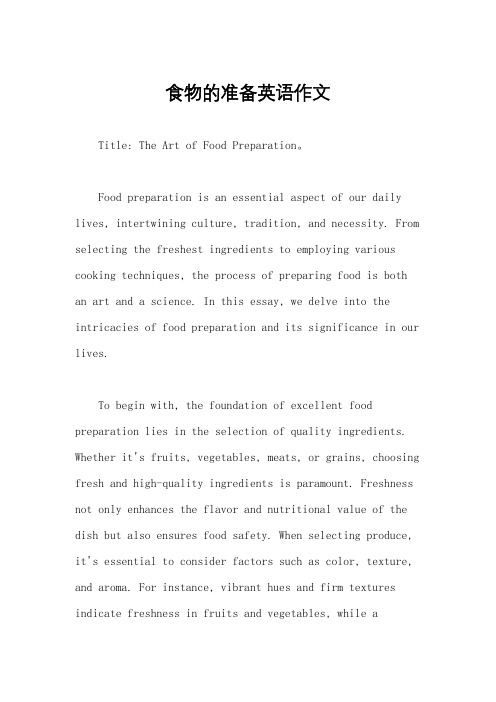
食物的准备英语作文Title: The Art of Food Preparation。
Food preparation is an essential aspect of our daily lives, intertwining culture, tradition, and necessity. From selecting the freshest ingredients to employing various cooking techniques, the process of preparing food is both an art and a science. In this essay, we delve into the intricacies of food preparation and its significance in our lives.To begin with, the foundation of excellent food preparation lies in the selection of quality ingredients. Whether it's fruits, vegetables, meats, or grains, choosing fresh and high-quality ingredients is paramount. Freshness not only enhances the flavor and nutritional value of the dish but also ensures food safety. When selecting produce, it's essential to consider factors such as color, texture, and aroma. For instance, vibrant hues and firm textures indicate freshness in fruits and vegetables, while apleasant aroma signifies the quality of herbs and spices.Once the ingredients are gathered, the next step is to prepare them for cooking. This may involve washing, peeling, chopping, or marinating, depending on the recipe. Proper preparation ensures that the ingredients are clean, uniform in size, and ready to impart their flavors to the dish. Moreover, certain techniques like marinating allow for the infusion of flavors, tenderization of meats, and enhancement of texture, resulting in a more flavorful and enjoyable meal.After the ingredients are prepped, it's time to employ various cooking techniques to transform them intodelectable dishes. Cooking methods vary widely and can include grilling, roasting, steaming, sautéing, boiling, and baking, among others. Each technique imparts unique flavors, textures, and aromas to the food, contributing to its overall appeal. For example, grilling imparts a smoky flavor and attractive grill marks to meats and vegetables, while roasting caramelizes sugars and enhances the natural sweetness of ingredients.Moreover, the skillful application of heat is crucial in achieving desired results in cooking. Controlling temperature and cooking times ensures that ingredients are cooked evenly and retain their nutritional value. Overcooking can result in loss of nutrients and undesirable texture, while undercooking may pose health risks due to inadequate food safety.In addition to cooking techniques, seasoning and flavoring play a vital role in enhancing the taste of dishes. Herbs, spices, condiments, and sauces add depth, complexity, and balance to flavors, elevating the overall dining experience. The judicious use of salt, pepper, garlic, onions, ginger, and other flavor enhancers can transform a simple dish into a culinary masterpiece.Furthermore, presentation is an essential aspect of food preparation, appealing to the senses and whetting the appetite. Attention to detail in plating, garnishing, and styling adds aesthetic value to the dish, making it more visually appealing and enticing. Creative presentationtechniques such as layering, stacking, and drizzling can turn a mundane meal into a work of art, worthy of admiration and appreciation.In conclusion, food preparation is a multifaceted process that requires attention to detail, skill, and creativity. From selecting quality ingredients to employing various cooking techniques and enhancing flavors, every step contributes to the creation of delicious and memorable dishes. Whether cooking for oneself, family, or friends, the art of food preparation enriches our lives, nourishes our bodies, and brings joy to our palates. So, let's embrace the journey of culinary exploration and savor the delights that food preparation has to offer.。
作文柴米油盐,诗和远方
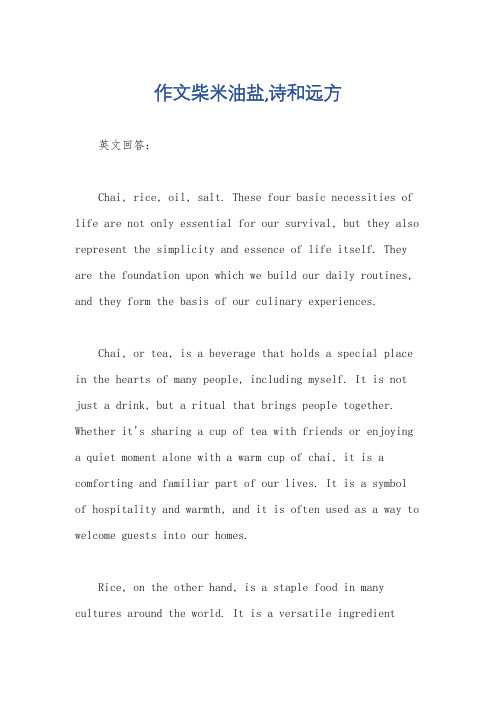
作文柴米油盐,诗和远方英文回答:Chai, rice, oil, salt. These four basic necessities of life are not only essential for our survival, but they also represent the simplicity and essence of life itself. They are the foundation upon which we build our daily routines, and they form the basis of our culinary experiences.Chai, or tea, is a beverage that holds a special place in the hearts of many people, including myself. It is not just a drink, but a ritual that brings people together. Whether it's sharing a cup of tea with friends or enjoying a quiet moment alone with a warm cup of chai, it is a comforting and familiar part of our lives. It is a symbol of hospitality and warmth, and it is often used as a way to welcome guests into our homes.Rice, on the other hand, is a staple food in many cultures around the world. It is a versatile ingredientthat can be used in a variety of dishes, from stir-fries to sushi. It is a source of sustenance, providing us with the energy we need to go about our daily lives. But rice is more than just a source of nourishment; it is also a symbol of abundance and prosperity. In many cultures, rice is associated with good luck and is often used in celebrations and rituals.Oil and salt may seem like simple ingredients, but they play a crucial role in enhancing the flavors of our food. Oil adds richness and depth to dishes, while salt brings out the natural flavors of ingredients. They are the seasonings that bring our meals to life, transforming a simple dish into a culinary delight. They are the ingredients that make our taste buds dance with joy.Poetry and distant lands are two things that have always fascinated me. Poetry is a form of expression that allows us to convey our thoughts and emotions in abeautiful and creative way. It is a way to connect with others and to explore the depths of our own souls. Whether it's the romantic verses of Shakespeare or the profoundwords of Rumi, poetry has the power to transport us to different times and places.As for distant lands, they are like a siren's call, beckoning us to explore and discover. They represent the unknown, the exotic, and the adventurous. They are the places that ignite our wanderlust and inspire us to stepout of our comfort zones. Whether it's the bustling streets of Tokyo or the serene beaches of Bali, distant lands offer us a chance to experience new cultures, meet new people,and broaden our horizons.中文回答:柴米油盐,这四样生活的基本必需品不仅是我们生存所必需的,也代表着生活的简单和本质。
介绍一种有趣的职业英语作文
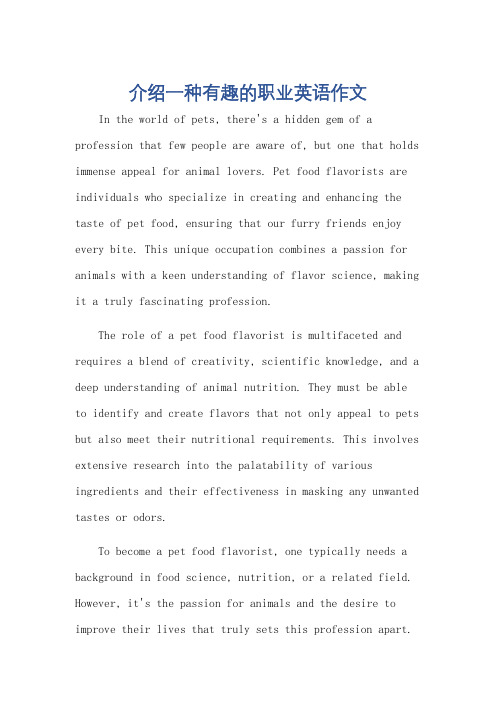
介绍一种有趣的职业英语作文In the world of pets, there's a hidden gem of a profession that few people are aware of, but one that holds immense appeal for animal lovers. Pet food flavorists are individuals who specialize in creating and enhancing the taste of pet food, ensuring that our furry friends enjoy every bite. This unique occupation combines a passion for animals with a keen understanding of flavor science, making it a truly fascinating profession.The role of a pet food flavorist is multifaceted and requires a blend of creativity, scientific knowledge, and a deep understanding of animal nutrition. They must be able to identify and create flavors that not only appeal to pets but also meet their nutritional requirements. This involves extensive research into the palatability of various ingredients and their effectiveness in masking any unwanted tastes or odors.To become a pet food flavorist, one typically needs a background in food science, nutrition, or a related field. However, it's the passion for animals and the desire to improve their lives that truly sets this profession apart.The ability to put oneself in the shoes of a pet and imagine what they might enjoy eating is crucial in creating successful pet food flavors.The work environment for a pet food flavorist can vary, with some working in research facilities or laboratories, while others might be employed by pet food manufacturing companies. Regardless of the setting, the job requires meticulous attention to detail and a commitment to continuous learning and improvement.The future of the pet food flavorist looks bright, as the pet industry continues to grow and evolve. With more pet owners seeking out high-quality, nutritious food options for their pets, the demand for skilled flavoristsis expected to increase. This provides ample opportunities for those interested in entering this rewarding field.Beyond the obvious benefits of improving pet nutrition and happiness, the role of a pet food flavorist also has a broader impact on society. By creating pet food that is both delicious and healthy, flavorists are contributing to the overall well-being of pets and their owners. This, in turn, can lead to stronger bonds between people and theirpets, improved animal welfare, and even positive effects on human health and happiness.In conclusion, the profession of pet food flavorist is not only fascinating but also incredibly rewarding. It offers a unique blend of creativity, science, and compassion for animals, making it a perfect fit for those who are passionate about pets and want to make a positive difference in their lives. As the pet industry continues to grow, so too will the opportunities for those willing to pursue this unique and fulfilling career path.**宠物食品调味师这一有趣的职业**在宠物世界里,有一个鲜为人知的职业,但对动物爱好者来说却极具吸引力。
好好吃饭的英语
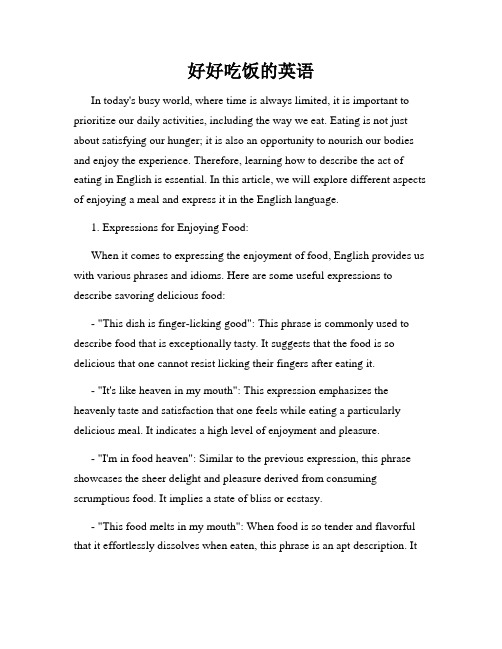
好好吃饭的英语In today's busy world, where time is always limited, it is important to prioritize our daily activities, including the way we eat. Eating is not just about satisfying our hunger; it is also an opportunity to nourish our bodies and enjoy the experience. Therefore, learning how to describe the act of eating in English is essential. In this article, we will explore different aspects of enjoying a meal and express it in the English language.1. Expressions for Enjoying Food:When it comes to expressing the enjoyment of food, English provides us with various phrases and idioms. Here are some useful expressions to describe savoring delicious food:- "This dish is finger-licking good": This phrase is commonly used to describe food that is exceptionally tasty. It suggests that the food is so delicious that one cannot resist licking their fingers after eating it.- "It's like heaven in my mouth": This expression emphasizes the heavenly taste and satisfaction that one feels while eating a particularly delicious meal. It indicates a high level of enjoyment and pleasure.- "I'm in food heaven": Similar to the previous expression, this phrase showcases the sheer delight and pleasure derived from consuming scrumptious food. It implies a state of bliss or ecstasy.- "This food melts in my mouth": When food is so tender and flavorful that it effortlessly dissolves when eaten, this phrase is an apt description. Ithighlights the sensation of the food easily disintegrating in the mouth, enhancing the overall taste.2. Vocabulary for Describing Taste:The taste of food is a crucial element in the culinary experience. To effectively describe the flavors, English offers a wide range of vocabulary. Let's explore some taste-related terms:- Sweet: This taste is characterized by a sugary or dessert-like flavor. It can refer to anything from fruits to chocolates or even pastries.- Salty: Refers to food that has a distinct salty or savory flavor. It is often associated with the taste of salt itself or ingredients such as bacon, cheese, or olives.- Sour: Describes a taste that is acidic or tangy, often associated with citrus fruits like lemons or grapefruits. Vinegar or pickled vegetables also have sour flavors.- Bitter: This taste can be described as sharp and almost unpleasant, often associated with coffee, dark chocolate, or certain types of vegetables like broccoli or kale.- Spicy: This taste refers to a burning or hot sensation on the tongue caused by chili peppers or strong spices, such as curry or paprika.3. Table Manners and Dining Etiquette:In addition to the language used to describe food, it is important to understand and practice proper table manners and dining etiquette. Here are some key points to keep in mind:- Use utensils appropriately: Mastering the use of forks, knives, and spoons is crucial for an enjoyable dining experience. Remember to hold your utensils correctly and use them in the appropriate order while eating.- Chew with your mouth closed: Avoid talking with food in your mouth and chew your food with your mouth closed. It is considered impolite and unappetizing to chew loudly or show the contents of your mouth while eating.- Wait for others to start: It is customary to wait for everyone at the table to be served before beginning to eat. This shows respect for others and creates a shared dining experience.- Use polite phrases: Expressing gratitude and politeness during a meal is important. Use phrases such as "Please pass the salt," "Thank you for the meal," or "May I have some water, please?" to create a pleasant atmosphere at the table.4. Food-Related Idioms and Proverbs:The English language is rich in idiomatic expressions and proverbs related to food. Understanding and using these idioms can add color and depth to your conversations. Here are a few examples:- "The proof is in the pudding": This idiom means that the true value or quality of something can only be determined by experiencing or testing it firsthand.- "I can't have my cake and eat it too": This proverb implies that one cannot have or enjoy two conflicting things at the same time. It reflects the concept of making choices and sacrifices.- "Like two peas in a pod": This idiom is used to describe two people who are very much alike or have a close relationship. It originates from the similarity of peas in a pod.- "You are what you eat": This proverb suggests that one's physical and mental well-being is influenced by the quality and type of food they consume.In conclusion, exploring the English language related to eating and food not only enhances our ability to communicate effectively but also allows us to appreciate the act of dining. By understanding expressions for enjoying food, vocabulary for describing taste, table manners, and food-related idioms, we can fully immerse ourselves in the cultural aspects of eating and enjoy meals to the fullest. So, let's savor delicious dishes, explore new flavors, and appreciate the experience of dining in English. Bon appétit!。
有关淀粉肠鸡骨泥的英文作文60词
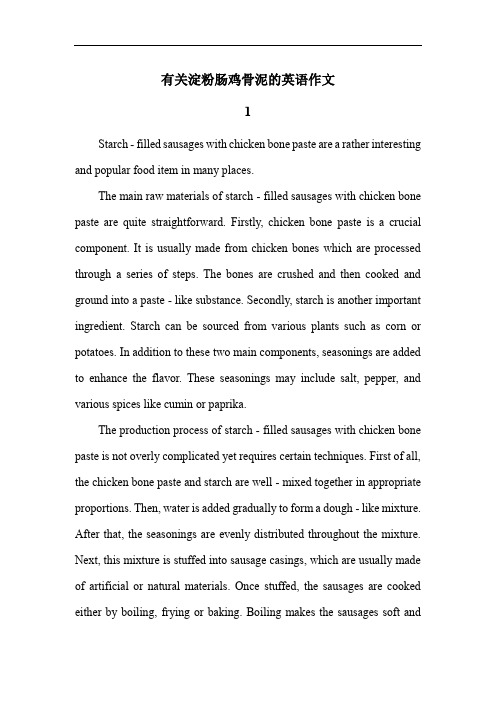
有关淀粉肠鸡骨泥的英语作文1Starch - filled sausages with chicken bone paste are a rather interesting and popular food item in many places.The main raw materials of starch - filled sausages with chicken bone paste are quite straightforward. Firstly, chicken bone paste is a crucial component. It is usually made from chicken bones which are processed through a series of steps. The bones are crushed and then cooked and ground into a paste - like substance. Secondly, starch is another important ingredient. Starch can be sourced from various plants such as corn or potatoes. In addition to these two main components, seasonings are added to enhance the flavor. These seasonings may include salt, pepper, and various spices like cumin or paprika.The production process of starch - filled sausages with chicken bone paste is not overly complicated yet requires certain techniques. First of all, the chicken bone paste and starch are well - mixed together in appropriate proportions. Then, water is added gradually to form a dough - like mixture. After that, the seasonings are evenly distributed throughout the mixture. Next, this mixture is stuffed into sausage casings, which are usually made of artificial or natural materials. Once stuffed, the sausages are cooked either by boiling, frying or baking. Boiling makes the sausages soft andjuicy, frying gives them a crispy outer layer while baking results in a more evenly cooked and somewhat drier texture.In some areas, starch - filled sausages with chicken bone paste are a common and beloved snack. For example, in many street food markets, they are sold as a ready - to - eat snack. V endors often fry them until they turn golden brown and then serve them with various dipping sauces such as ketchup or chili sauce. The crispy outer layer and the savory flavor inside make it a very satisfying snack for people on the go. Moreover, they can also be used in cooking other dishes. In some home - cooked meals, they are sliced and added to stir - fries. They blend well with vegetables like onions, peppers and cabbages, adding a unique flavor and a bit of meaty texture to the dish. In conclusion, starch - filled sausages with chicken bone paste are not only a simple food item but also a part of the local food culture in many regions.2Starch - filled sausages with chicken bone paste are a rather unique food item that holds significant nutritional value.Starch, as a major component in these sausages, is an important source of energy. It is a complex carbohydrate that is broken down slowly in our body, providing a steady release of glucose. This is especially beneficial for people who need a continuous supply of energy throughout the day, such as children and the elderly. Children are in a stage of rapid growth anddevelopment, and their high - energy - consuming bodies can make good use of the energy provided by starch. For the elderly, their metabolic rate may be slower, and the slow - release energy of starch can keep them active without causing sudden spikes in blood sugar.Now, let's turn our attention to the chicken bone paste. Chicken bone paste is rich in calcium, phosphorus, and other minerals. Calcium is crucial for building and maintaining strong bones and teeth. For children, it helps in the proper formation of their skeletal system as they grow. In the case of the elderly, it can help in preventing bone - related diseases such as osteoporosis. Moreover, the phosphorus in the chicken bone paste also plays an important role in energy metabolism and the formation of cell membranes.In addition to the above - mentioned nutrients, starch - filled sausages with chicken bone paste may also contain other elements like proteins, fats, and various vitamins. Proteins are essential for the growth and repair of body tissues, which is vital for both children and the elderly. Fats, in a proper proportion, can also provide energy reserve and help in the absorption of certain vitamins. Vitamins are necessary for various physiological functions in the body, such as maintaining good eyesight, a healthy immune system, etc.All in all, starch - filled sausages with chicken bone paste can be a very nutritious food option for certain groups of people. However, it shouldalso be consumed in moderation as it may contain some additives or high levels of fat and sodium in some cases. But when prepared in a healthy way, it can be a delicious and beneficial addition to the diet of children and the elderly.3In the vast realm of the food industry, starch - filled sausages and chicken bone paste play rather significant roles.Starch - filled sausages, which are quite common in the market, are a popular choice among consumers, especially in the fast - food and processed - food sectors. One of the most notable aspects of starch - filled sausages in the food industry is their cost - effectiveness in large - scale production. Manufacturers can significantly cut down on production costs by using starch as a major ingredient. Starch is a relatively inexpensive substance compared to pure meat, yet it can still provide a certain texture and bulk to the sausages. This cost advantage allows food companies to produce sausages at a lower cost per unit, making them more accessible to a wider range of consumers.Moreover, starch - filled sausages also have some functional characteristics in processed foods. For example, starch can help improve the mouthfeel of the sausages. It can create a certain softness and chewiness that many consumers find appealing. In addition, starch can also contribute to the overall flavor profile of the sausages. It can absorb and hold ontoseasonings and spices, enhancing the taste experience.When it comes to chicken bone paste, it also has its own unique place in the food industry. Chicken bone paste is often used as an ingredient in various processed foods. One of its main functions is to enhance the flavor. It contains a rich concentration of chicken - related flavors, which can be used to intensify the taste of products. For example, in some ready - to - eat soups or canned foods, the addition of chicken bone paste can give a more authentic and rich chicken flavor.In terms of cost, like starch - filled sausages, chicken bone paste can also offer cost advantages in large - scale production. It is made from parts of the chicken that might otherwise be discarded, which makes it a cost - efficient ingredient. This allows food manufacturers to produce high - quality - tasting products without incurring extremely high costs.Some well - known food brands have also incorporated these ingredients into their products. For instance, certain fast - food chains may use starch - filled sausages in their breakfast sandwiches. The sausages not only provide a filling and affordable option but also contribute to the overall taste and texture of the sandwich. Some processed - food brands that produce canned meats or ready - to - eat meals may use chicken bone paste to enhance the flavor of their products. This shows that starch - filled sausages and chicken bone paste are important components in the food industry, contributing to both the cost - effectiveness and the flavor andtexture aspects of a wide variety of products.4Starch - filled sausages with chicken bone paste are a rather unique and interesting food item. When it comes to the texture, it presents a quite distinct feel compared to ordinary sausages. Ordinary sausages usually have a relatively firm and somewhat elastic texture. However, the starch - filled sausages with chicken bone paste are a bit softer and more tender. The presence of the chicken bone paste in the starch - filled sausages imparts a special touch. It gives a more complex and rich flavor profile.The chicken bone paste adds a depth of umami flavor that is not commonly found in regular sausages. The flavor of the chicken bone paste blends well with the starch base, creating a harmonious combination. For example, when compared to a simple pork - based sausage, the starch - filled sausages with chicken bone paste have a more nuanced taste. The pork - based sausage may have a straightforward meaty flavor, while the starch - filled sausages with chicken bone paste offer a more multi - dimensional taste experience.When it comes to seasonings, there are some that can enhance the flavor of starch - filled sausages with chicken bone paste to a great extent. For instance, a sprinkle of black pepper can add a bit of spiciness and a warm, earthy note. The sharpness of the black pepper cuts through the richness of the chicken bone paste and the starch, creating a balanced andexciting taste on the palate. Another great combination is with a touch of honey mustard. The sweetness of the honey and the tanginess of the mustard interact with the unique flavor of the starch - filled sausages with chicken bone paste. The honey adds a pleasant sweetness that mellows out the overall flavor, while the mustard provides a zesty kick that wakes up the taste buds. All in all, starch - filled sausages with chicken bone paste are a delicious and unique food with their own special texture and flavor characteristics.5Starch - filled sausages with chicken bone paste have become a notable part of the food market in recent years.In terms of the current market situation, the consumption demand for starch - filled sausages with chicken bone paste is rather complex. On one hand, they are quite popular among certain consumer groups, especially those who are price - sensitive. These products are often relatively inexpensive compared to pure - meat sausages, which makes them an attractive option for people on a tight budget. They can be easily found in small grocery stores, convenience stores, and some street food stalls. In terms of production scale, many small - and medium - sized food processing factories are involved in the production of such products. Their production volumes are significant enough to meet the existing market demand, but at the same time, the production processes in some factoriesmay vary in terms of quality control.When it comes to the future development prospects, there are several factors to consider. With the increasing awareness of health among consumers, the development of starch - filled sausages with chicken bone paste is likely to face some challenges. In modern society, more and more people are concerned about the nutritional value and healthiness of the food they consume. Currently, some starch - filled sausages with chicken bone paste may be considered as less healthy due to their relatively high starch content and potential use of lower - quality chicken bone paste. However, this also presents an opportunity for improvement. Manufacturers may need to adapt to this trend by reformulating their products. For example, they could develop versions that are lower in fat and higher in protein. This could be achieved by using higher - quality chicken bone paste, which contains more lean protein, and reducing the amount of starch added.Moreover, in the face of competition from other food products, the marketing and branding of starch - filled sausages with chicken bone paste also need to be improved. They could be re - positioned as a convenient and affordable source of protein, rather than just a cheap alternative to sausages. In addition, stricter regulations regarding food safety and quality may also impact the production and sales of these products. Factories will need to invest more in quality control and food safety measures to meet the higher standards, which may lead to some consolidation in the industry,with smaller and less - compliant factories being phased out. Overall, the future of starch - filled sausages with chicken bone paste is full of both challenges and opportunities, and it will be interesting to see how the market evolves in the coming years.。
关于改进学校食堂的九年级英语作文
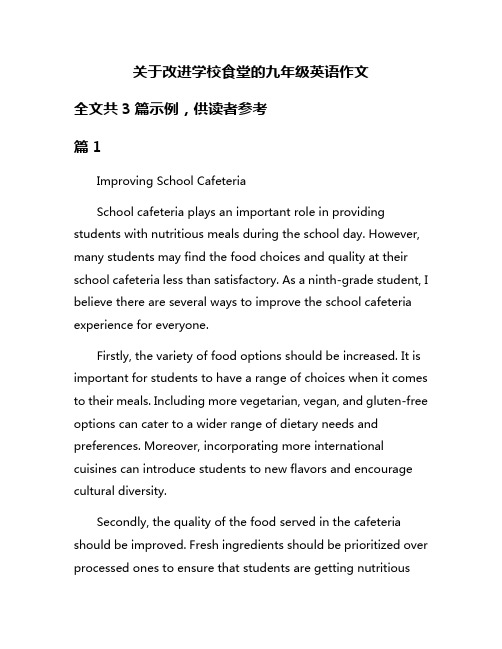
关于改进学校食堂的九年级英语作文全文共3篇示例,供读者参考篇1Improving School CafeteriaSchool cafeteria plays an important role in providing students with nutritious meals during the school day. However, many students may find the food choices and quality at their school cafeteria less than satisfactory. As a ninth-grade student, I believe there are several ways to improve the school cafeteria experience for everyone.Firstly, the variety of food options should be increased. It is important for students to have a range of choices when it comes to their meals. Including more vegetarian, vegan, and gluten-free options can cater to a wider range of dietary needs and preferences. Moreover, incorporating more international cuisines can introduce students to new flavors and encourage cultural diversity.Secondly, the quality of the food served in the cafeteria should be improved. Fresh ingredients should be prioritized over processed ones to ensure that students are getting nutritiousand wholesome meals. Additionally, the meals should be prepared in a way that retains their flavors and textures, making the dining experience more enjoyable for students.Thirdly, the cafeteria environment should be enhanced to create a welcoming and comfortable space for students to eat and socialize. Adding more seating options, such as booths or high tables, can accommodate different group sizes and preferences. Furthermore, incorporating plants and art pieces can liven up the space and make it more aesthetically pleasing.In conclusion, improving the school cafeteria can have a positive impact on students' overall well-being and academic performance. By increasing food variety, improving food quality, and enhancing the cafeteria environment, students will be more likely to enjoy their meals and feel satisfied with their dining experience. As a ninth-grade student, I believe that these changes are essential in creating a healthy and vibrant school cafeteria.篇2Improving School CafeteriaThe school cafeteria is an important part of every school. It is where students gather to eat, socialize, and refuel during thebusy school day. However, many students and staff members feel that there is room for improvement in our school cafeteria.One issue that many people have with the cafeteria is the food options. While the cafeteria staff work hard to provide nutritious meals, some students feel that there is not enough variety in the menu. Many students would like to see more healthy options, such as fresh fruits and vegetables, available on a daily basis. In addition, some students have dietary restrictions or preferences that are not accommodated by the current menu. By offering a wider range of options, the cafeteria could better meet the needs of all students.Another common complaint about the cafeteria is the long lines and wait times. During the lunch period, the cafeteria can become crowded and chaotic, leading to long lines and wait times. This can make it difficult for students to get their food quickly and efficiently, and can cut into their already limited lunch period. By implementing strategies to streamline the lunch process, such as offering pre-ordering options or increasing the number of serving stations, the cafeteria could help alleviate this issue.In addition to food options and wait times, the overall atmosphere of the cafeteria is also a concern for many studentsand staff members. Some people feel that the cafeteria lacks a welcoming and comfortable environment, with cramped seating and outdated decor. By making small changes, such as updating the furniture, adding more natural light, or playing music during lunchtime, the cafeteria could become a more enjoyable and inviting space for students.Overall, there are many ways that our school cafeteria could be improved to better meet the needs of students and staff. By listening to feedback, making changes to the menu, streamlining the lunch process, and enhancing the atmosphere, the cafeteria could become a more positive and enjoyable part of the school day.篇3Improving School CafeteriaSchool cafeteria plays a crucial role in providing nutritious meals for students. However, many students often find the food lacking in taste, variety, and nutrition. Therefore, it is important to make improvements in the school cafeteria to ensure that students have access to healthy and delicious meals.First and foremost, the menu in the school cafeteria should be diversified. Offering a wide range of options such as fruits,vegetables, whole grains, and lean proteins will not only provide students with a balanced diet but also cater to different preferences. Additionally, the cafeteria should include more culturally diverse dishes to reflect the diverse student population.Furthermore, the quality of the food served in the cafeteria should be improved. Using fresh ingredients and cooking methods that retain nutrients will enhance the overall taste and nutritional value of the meals. Additionally, reducing the amount of processed foods and added sugars in the menu will promote better health among students.In order to encourage students to make healthier choices, nutrition education should be integrated into the school curriculum. Teaching students about the importance of a balanced diet and how to make informed food choices will empower them to make healthier decisions in the cafeteria and beyond.Another important aspect of improving the school cafeteria is the dining environment. Creating a welcoming and clean space with sufficient seating will enhance the overall dining experience for students. Additionally, providing opportunities for studentsto give feedback on the cafeteria menu and services will help in addressing their needs and preferences.In conclusion, making improvements in the school cafeteria is essential for promoting the health and well-being of students. By diversifying the menu, improving food quality, providing nutrition education, and creating a positive dining environment, schools can ensure that students have access to healthy and delicious meals. It is important for schools to prioritize thewell-being of their students and take proactive measures to improve the cafeteria experience.。
关于一个习惯的英语作文

关于一个习惯的英语作文The Habit of Mindfulness.In the bustling tapestry of modern life, where distractions abound and the relentless pace of technology threatens to overwhelm our senses, the practice of mindfulness offers a beacon of serenity and clarity. Mindfulness is the art of being fully present and aware in the current moment, without judgment or expectation. It is a practice that has been cultivated for centuries in various traditions, including Buddhism, Taoism, and Yoga, and has gained increasing recognition in recent years as a tool for reducing stress, improving focus, and enhancing overall well-being.At its core, mindfulness is the ability to observe our thoughts, feelings, and bodily sensations with a non-reactive awareness. Rather than becoming entangled in the whirlwind of our inner world, we learn to step back and witness our experiences with a sense of detached curiosity.This allows us to recognize the impermanence of our thoughts and emotions, and to understand that they do not define who we are.Embracing mindfulness as a habit involves cultivating a consistent practice of paying attention to the present moment. This can be achieved through various techniques, such as meditation, yoga, or simply taking a few mindful breaths throughout the day. By dedicating a small amount of time each day to this practice, we can gradually train our minds to become more attentive and less reactive to the ebb and flow of our experiences.One of the most profound benefits of mindfulness is its ability to reduce stress and promote relaxation. When we are constantly dwelling on the past or worrying about the future, we create a state of chronic stress that can take a significant toll on our physical and mental health. Mindfulness helps us to break free from this cycle by grounding us in the present moment. By focusing on the sensations of our breath or the sounds of our surroundings, we can quiet the chatter of our minds and create a sense ofinner peace.Furthermore, mindfulness has been shown to improve our focus and concentration. In an era where our attention is constantly fragmented by external stimuli, mindfulness provides a powerful tool for honing our ability to stay focused on the task at hand. By practicing mindfulness, we can learn to resist distractions and develop a greater capacity for sustained attention.Beyond its cognitive benefits, mindfulness also has a transformative impact on our emotional well-being. By observing our emotions with a non-judgmental awareness, we can begin to understand their nature and develop healthier coping mechanisms. Mindfulness helps us to recognize that our emotions are not permanent and that we have the power to choose how we respond to them. This leads to a greater sense of emotional resilience and a reduced susceptibility to stress and anxiety.The practice of mindfulness extends beyond the confines of formal meditation or yoga sessions. It is a way of lifethat can be integrated into every aspect of our day-to-day existence. Whether we are eating, showering, or working, we can cultivate a mindful awareness of our present moment experiences. By paying attention to the taste of our food, the warmth of the water on our skin, or the sensations in our bodies as we move, we can transform even the most mundane tasks into opportunities for presence and gratitude.As we deepen our practice of mindfulness, we may beginto notice subtle shifts in our perception of the world and ourselves. The rigid boundaries of our ego may dissolve,and we may experience a greater sense of interconnectedness with all beings. Mindfulness fosters a sense of compassion and empathy, allowing us to see the suffering of otherswith a more open heart and to respond with kindness and understanding.Embracing the habit of mindfulness is a journey, not a destination. It requires consistent effort and dedication, but the rewards are immeasurable. As we cultivate a deeper connection to the present moment, we unlock a wellspring of inner peace, resilience, and wisdom. Mindfulness empowersus to live our lives with greater intention, clarity, and compassion, creating a profound and lasting transformation in our relationship to ourselves and the world around us.。
餐巾纸是甜600字作文
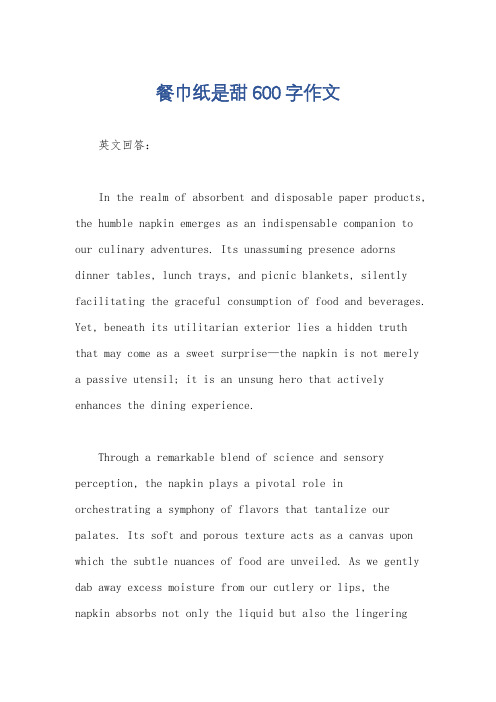
餐巾纸是甜600字作文英文回答:In the realm of absorbent and disposable paper products, the humble napkin emerges as an indispensable companion to our culinary adventures. Its unassuming presence adorns dinner tables, lunch trays, and picnic blankets, silently facilitating the graceful consumption of food and beverages. Yet, beneath its utilitarian exterior lies a hidden truth that may come as a sweet surprise—the napkin is not merely a passive utensil; it is an unsung hero that actively enhances the dining experience.Through a remarkable blend of science and sensory perception, the napkin plays a pivotal role inorchestrating a symphony of flavors that tantalize our palates. Its soft and porous texture acts as a canvas upon which the subtle nuances of food are unveiled. As we gently dab away excess moisture from our cutlery or lips, the napkin absorbs not only the liquid but also the lingeringaromatics and flavors that cling to the surface.In this culinary dance, the napkin becomes a silent ally, enhancing the taste of food by eliminating distractions and allowing the pure flavors to shine. It absorbs excess oil, leaving behind a crisp and satisfying texture. It captures unwanted bitterness and acidity, preventing them from overwhelming our taste buds. And by preventing the mingling of flavors from different dishes, it ensures that each culinary creation retains its distinct identity.Beyond its gustatory contributions, the napkin also plays a crucial role in the social etiquette of dining. It serves as an unspoken symbol of refinement, a subtle reminder to maintain cleanliness and grace at the table. It discreetly conceals errant crumbs, lipstick marks, and other minor mishaps, preventing them from becomingunsightly distractions. In this way, the napkin not only enhances the dining experience but also fosters a sense of decorum and shared social norms.To fully appreciate the napkin's sweet and multifaceted nature, let us delve into a specific culinary scenario. Imagine savoring a juicy and flavorful steak. As you cutinto the tender flesh, a burst of succulent juices escapes, threatening to leave an unappetizing residue on your hands. But in this moment of culinary crisis, the napkin swoops in like a savior. With a gentle wipe, it absorbs the excess moisture, leaving your hands clean and ready for the next delectable bite.As you continue your meal, you notice a lingering bitterness in your mouth from the accompanying red wine. Instead of reaching for water to quench the unwanted flavor, you discreetly blot your lips with the napkin. To your delight, the napkin effectively captures the bitter tannins, allowing you to fully enjoy the rich and velvety flavors of the wine without any unpleasant distractions.The napkin's culinary prowess extends beyond meat and wine. It is equally adept at enhancing the delicate flavors of seafood, the sweetness of fruit, and the umami-richnessof vegetables. Whether you are enjoying a fresh oyster onthe half shell, savoring a ripe strawberry, or indulging in a stir-fried vegetable medley, the napkin serves as an indispensable companion, subtly elevating the dining experience with each use.In conclusion, the napkin is not merely a disposable paper product but a culinary chameleon that plays a vital role in enhancing the taste of food, fostering social etiquette, and orchestrating a truly memorable dining experience. It is a sweet and often overlooked companion that deserves our appreciation and recognition. As we gather around the dinner table, let us raise our glasses to the humble napkin, an unsung hero that silently transforms our culinary adventures into moments of pure delight.中文回答:餐巾纸是甜的。
用英语写鼻子的作文
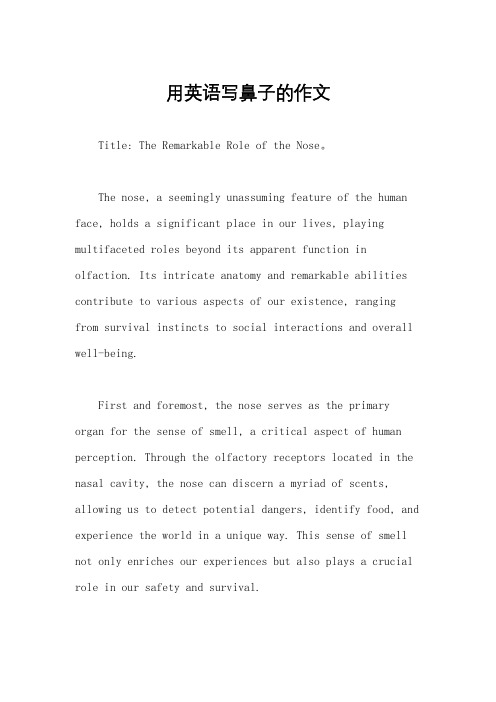
用英语写鼻子的作文Title: The Remarkable Role of the Nose。
The nose, a seemingly unassuming feature of the human face, holds a significant place in our lives, playing multifaceted roles beyond its apparent function in olfaction. Its intricate anatomy and remarkable abilities contribute to various aspects of our existence, ranging from survival instincts to social interactions and overall well-being.First and foremost, the nose serves as the primary organ for the sense of smell, a critical aspect of human perception. Through the olfactory receptors located in the nasal cavity, the nose can discern a myriad of scents, allowing us to detect potential dangers, identify food, and experience the world in a unique way. This sense of smell not only enriches our experiences but also plays a crucial role in our safety and survival.Moreover, the nose is intricately linked to the sense of taste, enhancing our enjoyment of food and beverages. The olfactory receptors in the nasal cavity work in tandem with taste receptors on the tongue, creating a synergistic sensory experience. This phenomenon explains why flavors seem diminished when one's nose is congested, highlighting the indispensable role of the nose in our perception of taste.Beyond its sensory functions, the nose also plays a pivotal role in respiratory health and overall well-being. It acts as a natural air filter, trapping airborneparticles and pathogens before they can reach the delicate tissues of the respiratory system. Additionally, the nose humidifies and warms incoming air, optimizing its conditions for the lungs. These mechanisms help protect the respiratory system from irritants and infections, contributing to our overall health and vitality.Furthermore, the nose is an essential component of facial aesthetics and identity. Its size, shape, and symmetry can significantly influence one's facialappearance and perception of attractiveness. For centuries, artists and sculptors have paid meticulous attention to the nuances of the nose in their depictions of human faces, recognizing its profound impact on facial harmony and expression.In addition to its physiological functions, the nose plays a crucial role in social interactions and communication. Facial expressions, including thoseinvolving the nose, convey a wealth of information about one's emotions, intentions, and personality traits. From a subtle wrinkle of the nose to a contagious smile, these nonverbal cues facilitate interpersonal connections and enrich our social experiences.Moreover, the nose is central to the phenomenon of pheromones, chemical signals that play a role in human attraction and mate selection. While the science behind human pheromones is still evolving, evidence suggests that the nose may subconsciously detect these chemical signals, influencing interpersonal dynamics and reproductive behavior.In conclusion, the nose is far more than a mere protrusion on the face; it is a remarkable organ with multifaceted functions that extend beyond the realms of smell and respiration. From its role in sensory perception to its impact on aesthetics, health, and social interactions, the nose exemplifies the complexity and ingenuity of the human body. As we continue to unravel its mysteries and appreciate its significance, let us not overlook the extraordinary capabilities of this seemingly ordinary feature.。
一家人的爱好英语作文
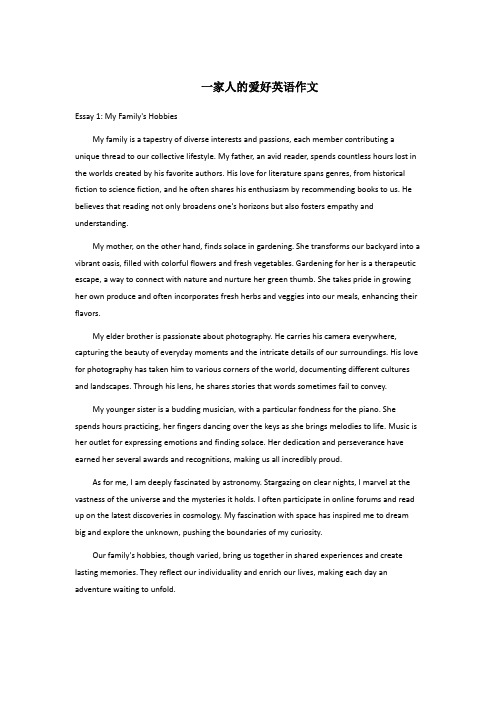
一家人的爱好英语作文Essay 1: My Family's HobbiesMy family is a tapestry of diverse interests and passions, each member contributing a unique thread to our collective lifestyle. My father, an avid reader, spends countless hours lost in the worlds created by his favorite authors. His love for literature spans genres, from historical fiction to science fiction, and he often shares his enthusiasm by recommending books to us. He believes that reading not only broadens one's horizons but also fosters empathy and understanding.My mother, on the other hand, finds solace in gardening. She transforms our backyard into a vibrant oasis, filled with colorful flowers and fresh vegetables. Gardening for her is a therapeutic escape, a way to connect with nature and nurture her green thumb. She takes pride in growing her own produce and often incorporates fresh herbs and veggies into our meals, enhancing their flavors.My elder brother is passionate about photography. He carries his camera everywhere, capturing the beauty of everyday moments and the intricate details of our surroundings. His love for photography has taken him to various corners of the world, documenting different cultures and landscapes. Through his lens, he shares stories that words sometimes fail to convey.My younger sister is a budding musician, with a particular fondness for the piano. She spends hours practicing, her fingers dancing over the keys as she brings melodies to life. Music is her outlet for expressing emotions and finding solace. Her dedication and perseverance have earned her several awards and recognitions, making us all incredibly proud.As for me, I am deeply fascinated by astronomy. Stargazing on clear nights, I marvel at the vastness of the universe and the mysteries it holds. I often participate in online forums and read up on the latest discoveries in cosmology. My fascination with space has inspired me to dream big and explore the unknown, pushing the boundaries of my curiosity.Our family's hobbies, though varied, bring us together in shared experiences and create lasting memories. They reflect our individuality and enrich our lives, making each day an adventure waiting to unfold.Essay 2: The Diverse Interests of My Loved OnesIn the tapestry of my family, each member's hobbies add vibrant hues to our daily existence. My father, a tech enthusiast, is always at the forefront of technological advancements. He spends his free time tinkering with gadgets, from smartphones to drones, and enjoys teaching us about the latest innovations. His fascination with technology drives him to stay updated, ensuring we are all equipped with the knowledge to navigate our digital world.My mother, a dedicated yoga practitioner, finds balance and tranquility through her daily practice. She believes in the mind-body connection and often encourages us to join her for a session. Yoga for her is not just a physical exercise but a spiritual journey that promotes mindfulness and inner peace. Her dedication has rubbed off on us, making us more aware of our mental and emotional well-being.My older brother is a fitness freak, passionate about weightlifting and marathon running. His mornings are dedicated to intense workouts, and he often participates in marathons across the country. His commitment to fitness has inspired us to adopt healthier lifestyles, emphasizing the importance of physical activity. His achievements serve as a testament to perseverance and dedication.My younger sister, a budding artist, finds joy in expressing herself through painting and sketching. Her room is adorned with her creations, each piece telling a story or conveying an emotion. Art for her is a form of self-expression and therapy, allowing her to channel her thoughts and feelings onto canvas.As for me, I am a avid traveler, always eager to explore new places and cultures. My love for travel stems from a desire to broaden my horizons and understand different perspectives. Every trip is a lesson, teaching me about the world's diversity and interconnectedness. Traveling has made me more adaptable and open-minded, enriching my life in ways that are beyond measure.Our diverse interests, though different, weave a tapestry of unity and love, bringing us closer and creating a home filled with joy and curiosity.Essay 3: The Passions That Bind UsMy family is a tapestry of individual passions and hobbies, each one contributing to our collective happiness and growth. My father, a history buff, spends his evenings lost in booksabout ancient civilizations and historical events. His love for history is infectious, and he often shares fascinating stories, sparking our curiosity and fostering a love for learning.My mother, a culinary artist, finds joy in experimenting with new recipes and perfecting her cooking skills. Her kitchen is a laboratory of flavors, where she blends traditional and modern ingredients to create mouth-watering dishes. Our family dinners are a feast for the senses, reflecting her creativity and dedication to feeding our souls through food.My older brother is a video game enthusiast, with a particular fondness for strategy games. He spends hours strategizing and problem-solving, his passion for gaming fueling his analytical thinking and teamwork skills. His love for games has also brought us closer, as we often play together, creating lasting memories and bonding over shared experiences.My younger sister is a budding dancer, with a natural grace and rhythm. She takes ballet and jazz classes, her movements a testament to the beauty of art and movement. Dancing for her is a form of self-expression and a way to connect with her inner self. Her performances are a joy to watch, filling our hearts with pride and admiration.As for me, I am deeply fascinated by psychology, particularly the study of human behavior and emotions. I spend my free time reading about psychological theories and conducting informal experiments with my family and friends. My interest in psychology has made me more empathetic and understanding, helping me navigate complex social interactions with ease.Our hobbies, though varied, bring us together, creating a home filled with love, curiosity, and a shared passion for life. They are the threads that bind us, making us a family of individuals who cherish and celebrate our differences.Essay 4: The Colors of Our PassionsIn the tapestry of my family, each member's hobbies add a unique and vibrant hue to our collective existence. My father, a nature lover, spends his weekends hiking and birdwatching. His passion for the outdoors is contagious, and he often takes us on adventures, teaching us about the wonders of nature and the importance of conservation.My mother, a dedicated knitter, finds joy in creating beautiful garments and accessories from scratch. Her hands are a magic wand, transforming yarn into works of art. Knitting for her is a way to relax and unwind, her creativity shining through every stitch. Her handmade items arecherished treasures, warming our hearts and bodies.My older brother is a film buff, with an extensive knowledge of cinema. He spends his evenings watching classic and contemporary films, analyzing their themes and techniques. His love for film has sparked a shared interest in us, and we often have movie nights, exploring different genres and discussing our favorite films.My younger sister is a budding chef, with a passion for baking. She spends hours in the kitchen, experimenting with new recipes and perfecting her techniques. Her creations are a delight to taste, and she often brings them to family gatherings, spreading joy and sweetness with every bite.As for me, I am deeply fascinated by science, particularly the study of the cosmos. I spend my nights stargazing, learning about constellations and celestial events. My love for science has inspired me to pursue a career in the field, driving me to learn and explore the mysteries of the universe.Our hobbies, though diverse, bring us together in shared experiences and create a sense of belonging. They are the colors that paint our family portrait, making us a unique and beautiful tapestry of individual passions and dreams.Essay 5: The Threads of Our LivesIn the tapestry of my family, each member's hobbies weave a story of individuality and unity. My father, a fisherman, finds peace and fulfillment on the water. His mornings are spent casting nets and enjoying the tranquility of the sea. Fishing for him is not just a hobby but a way of life, one that teaches us the value of patience, resilience, and respect for nature.My mother, a language enthusiast, spends her days learning new languages and cultures. She believes in the power of communication and often practices her language skills with us, fostering a love for diversity and inclusion. Her dedication has inspired us to embrace multilingualism, making us more adaptable and open-minded.My older brother is a musician, with a particular fondness for the guitar. He spends hours playing and composing, his music echoing through our home, bringing joy and harmony. His passion for music has brought us closer, as we often sing and play together, creating lasting memories and bonding over shared experiences.My younger sister is a budding writer, with a creative imagination and a love for storytelling. She spends her free time penning short stories and poems, her words painting vivid pictures and evoking strong emotions. Her writing reflects her inner world, a place of wonder and imagination. Reading her stories is a joy, filling our hearts with warmth and inspiration.As for me, I am deeply fascinated by photography and videography. I capture moments, freezing time and preserving memories. My love for visual storytelling has led me to explore different mediums and techniques, always striving to create something unique and meaningful.Our hobbies, though different, create a tapestry of unity and love. They are the threads that bind us, making us a family of individuals who cherish and celebrate our differences. Together, we create a beautiful and diverse tape。
扬州炒饭的做法英语作文

扬州炒饭的做法英语作文示例作文篇一:English:"A Symphony of Flavor: The Art of Yangzhou Fried Rice - A Culinary Journey"In the vast expanse of Chinese culinary traditions, Yangzhou Fried Rice stands as a testament to the harmony between simplicity and sophistication. This humble dish, rooted in the city of Yangzhou, has transcended generations, bing a symbol of China's rich gastronomic heritage. Let us delve into the artistry and the essence of this iconic creation.The preparation of Yangzhou Fried Rice begins with a symphonyof ingredients, each playing its part. It starts with the base of aromatic long-grain rice, cooked to a perfect texture, neither too soft nor too hard. The secret lies in the overnight soaking, allowing the grains to absorb moisture, resulting in a delicate separation when fried.Next, the key ingredient - eggs, skillfully scrambled into a golden web, adds a lustrous sheen and a delightful contrast in texture. Diced ham, shrimp, and vegetables such as peas and carrots, harmoniously blend together, adding color and flavor. The addition of local condiments like soy sauce, sugar, and sesame oil, with their subtle balance, elevates the dish to new heights.The technique employed in stir-frying is another aspect that showcases the finesse of Yangzhou Fried Rice. The wok, heated to a fiery blaze, demands quick and deft movements. The chef must constantly toss and fold, ensuring every grain is coated in the savory sauce, while maintaining the integrity of the ingredients.But what truly sets Yangzhou Fried Rice apart is its storytelling quality. Each bite carries a memory, a reminder of family gatherings, hearty meals shared among friends, or nostalgic journeys through time. It is a culinary embodiment of the Chinese philosophy of 'wen' or harmony, where flavors, textures, and memories intertwine seamlessly.In a world where fast food culture prevails, Yangzhou Fried Rice invites us to pause, appreciate the craftsmanship that goes into each plate, and savor the simple pleasures of life. It is not just a dish; it's a culinary journey, a piece of history, and a testament to the rich cultural tapestry of China.In conclusion, the making of Yangzhou Fried Rice is an art form, a testament to the patience, skill, and love for food. It is a reminder that even the most humble dishes can carry profound significance, offering a window into a nation's soul. Next time you lift your fork to this classic creation, let the flavors resonate, and the story unfold in your mouth.中文:A Savorful Journey: The Art of Yangzhou Fried RiceIn the bustling streets of ancient China, a culinary masterpiece quietly whispers its secrets - Yangzhou Fried Rice. This humble dish, with its profound flavors and cultural significance, has transcended generations, bing a canvas that paints the essence of Chinese gastronomy.The story of Yangzhou Fried Rice begins in the city of Yangzhou, nestled along the picturesque Yangtze River. It was here, in the heart of the prosperous Han Dynasty, that chefsbined their culinary prowess with local ingredients, crafting a dish thatwould later be a symbol of simplicity and elegance. Each grain of rice, carefully selected and stir-fried to a golden sheen, carries the warmth of home-cooked meals and the memories of countlessfamily gatherings.The art of making Yangzhou Fried Rice lies not just in the choice of ingredients, but also in the meticulous preparation.Aged eggs, diced ham, fresh peas, and crunchy peanuts are harmoniously blended into the mix, creating a symphony of textures and tastes. The secret ingredient, however, is the touch of Shaoxing wine, which imparts a subtle depth, enhancing the overall flavor without overpowering it.Each stir-fry is a dance, a performance of patience and skill. The chef must maintain the perfect balance between heat and technique, ensuring that each ingredient is cooked to perfection without losing its individuality. The aroma that wafts from the wok is a testament to the dedication and craftsmanship that goes into every plate of Yangzhou Fried Rice.Beyond its gastronomic allure, this dish embodies the values of Chinese culture. It represents the importance of preserving tradition while embracing innovation, much like how the city of Yangzhou itself has evolved over time. In every spoonful, one can taste the resilience and adaptability that has shaped the Chinese spirit.Yangzhou Fried Rice is more than just a meal; it's a journey through history, a tribute to the culinary heritage, and a reminder of the simple pleasures life has to offer. As I savor each bite, I am transported back in time, feeling the warmth of family bonds and the richness of our shared culinary legacy.In conclusion, the art of Yangzhou Fried Rice is not merely about food, but a testament to the beauty of tradition, the power of memory, and the joy ofmunal dining. It is a dish that transcends borders, appealing to the senses and the soul, inviting us all to embark on a flavorful adventure through the culinary wonders of China.示例作文篇二:English:"A Glimpse into the Art of Yangzhou Fried Rice: A Culinary Delight and Cultural Reflection"In the vast tapestry of Chinese culinary arts, Yangzhou Fried Rice stands as a testament to the harmonious fusion of flavors, history, and tradition. As a student with a passion for both food and culture, I would like to share my exploration of this delectable dish that transcends mere sustenance.The origins of Yangzhou Fried Rice can be traced back to the city's prosperous past, during the Han and Tang dynasties. It is not just a simple stir-fry of rice but a symphony of textures, colors, and aromas that reflect the city's rich maritime trade and cultural exchange. Each grain, from the fluffy basmati to the savory bits of egg, carries a story within its humble beginnings.To prepare authentic Yangzhou Fried Rice, one begins by using day-old rice, which imparts a delightful chewiness. The key ingredient, however, is the meticulous technique of cooking. The rice is fried in a wok until it attains a caramelized glaze, a process that requires patience and finesse. This golden layer, known as "rou," adds depth andplexity to the dish.Nextes the ensemble of ingredients - diced ham, shrimp, bamboo shoots, peas, and various seasonings. Each ingredient is cooked separately, ensuring they retain their distinct flavors before beingbined with the rice. The addition of spring onion, ginger, and soy sauce adds a fragrant touch, while the sweetness of sugar tempers the overall taste.Beyond its gastronomic appeal, Yangzhou Fried Rice embodies the essence of Chinese cuisine's philosophy. It teaches us about balance, where every ingredient has a purpose, and the importance of preserving tradition while embracing innovation. In a world where globalization is blurring culinary boundaries, Yangzhou Fried Rice serves as a reminder of the richness that lies in preserving local culinary heritage.In conclusion, the art of making Yangzhou Fried Rice is more than just a recipe; it's a journey through history, culture, and the human connection to food. It is a dish that connects generations, bridging gaps and fostering understanding. As a student, I find solace in its simplicity, yet profoundness, and strive to appreciate not just its taste, but also the stories it carries. For me, Yangzhou Fried Rice is not just a meal, but a tangible expression of China's rich culinary legacy.中文:A Fiery Symphony: The Art of Yangzhou Fried RiceIn the bustling streets of ancient China, a humble dish, Yangzhou Fried Rice, weaves a symphony of flavors that transcends time and culture. It's not just a meal, but a testament to the culinary wisdom and the spirit of Chinese craftsmanship.Yangzhou Fried Rice, with its origins dating back centuries,is a culinary masterpiece that reflects the city's rich history. Each grain of rice, stir-fried with love and precision, carriesthe echoes of past dynasties. The key ingredient, long-grained glutinous rice, is patiently aged to attain its signature softness, while eggs, diced ham, shrimp, and vegetables harmoniously blend into a tapestry of colors and textures.The art begins in the preparation, where each ingredient is treated with respect. The eggs are gently scrambled to form a delicate, golden web, while the vegetables are stir-fried untilthey retain their crispiness. The secret lies in the technique of wok hei, a term that embodies the essence of high heat and quick, even cooking, which caramelizes the rice and imparts a depth of flavor.As the dishes together, it's not merely about the sum of its parts, but the interplay of tastes and aromas. The sweetness from the shrimp and ham dances with the savory soy sauce, while the crunch of peas adds a refreshing contrast. The aroma, a headyblend of cooked rice, spices, and fried eggs, evokes memories of home for many, and for outsiders, it opens doors to the warmth and hospitality of Chinese cuisine.Yangzhou Fried Rice, more than just a simple dish, is a symbol of tradition passed down through generations. It teaches us the value of preserving culinary heritage while embracing innovation.In every stir, every bite, one can feel the connection to the past, the present, and the future.In today's fast-paced world, this dish reminds us to savor the small moments, to appreciate the artistry in everyday life. Likethe skilled hands that craft it, we too must take care to preserve and nurture our traditions, ensuring they continue to thrive inthe ever-changing landscape.In conclusion, Yangzhou Fried Rice is a culinary journey that encapsulates the essence of Chinese cuisine and the human spirit. It is a dish that whispers stories of the past, celebrates the present, and inspires us to embrace the future. So, the next time you take a spoonful of this fiery symphony, let it transport you to the heart of China, where the dance of flavors never ceases to amaze.示例作文篇三:English:A Culinary Odyssey: Mastering the Art of Yangzhou Fried RiceIn the vast tapestry of Chinese culinary culture, Yangzhou fried rice stands as a cherished dish, not just for its rich flavors but also for the artful blend of history and tradition it embodies. As a student, I have had the privilege to delve into this gastronomic delight, and I would like to share with you the essence of its creation.Yangzhou fried rice, or "Yangzhou Xiaolongzi" in Chinese, is more than just a simple stir-fry of rice and vegetables. It is a symphony of colors, textures, and aromas that dance on a plate, telling a story of the city's past. The secret lies in the meticulous preparation and the harmoniousbination of ingredients.To begin, the key ingredient is the day-old rice, whichimparts a delightful chewiness and separates beautifully whenstir-fried. The process starts with sautéing diced onions, garlic, and ginger in a wok until fragrant, creating a base for the dish's aromatic foundation. Then, diced ham, shrimp, and various vegetables such as peas, carrots, and mushrooms are added, cooked until they retain their freshness.The pièce de résistance is the technique of adding scrambled eggs, gently folding them into the rice, ensuring that each grain is coated in a luscious golden layer. This step is where the artistry truly lies, as it requires patience and skill to achieve the perfect balance between the fluffy egg and the fluffy rice.Yangzhou fried rice is not just about taste; it is also a visual feast. The array of colors – from the vibrant green peas to the golden eggs, the red diced ham, and the translucent vegetables – creates a stunning contrast on the plate, inviting the diner to take a bite.Moreover, this dish carries cultural significance. In ancient times, the wealthy merchants of Yangzhou would prepare this dish for their guests as a symbol of hospitality and prosperity. Today, it has be a symbol of unity, as people from different walks oflife gather around a steaming bowl of Yangzhou fried rice, sharing stories and laughter.In conclusion, learning to make Yangzhou fried rice is notonly a culinary adventure but also a journey into understanding the depth and richness of Chinese culture. It teaches us the value of tradition, the importance of attention to detail, and the joy of bringing people together over a shared meal. So, the next time you savor a mouthful of this delectable dish, remember, every grain tells a story, and every stir-fry is an ode to the culinary heritage of Yangzhou.中文:A Symphony of Flavor: The Art of Yangzhou Fried RiceIn the vast canvas of Chinese culinary arts, Yangzhou fried rice stands as a symphony of flavors, a harmonious blend of history, tradition, and regional identity. This humble dish, more than just a plate of rice, tells a story of China's rich gastronomic heritage.The origins of Yangzhou fried rice date back to ancient times, where it evolved from the imperial banquets of the Yangzhou region. Each grain, stir-fried with precision, carries the echoes of a bygone era, whispering tales of skilled chefs and their dedication to crafting a masterpiece on every plate. The dish's very name, "Fuhai Fen," translates to "sea of rice," symbolizing its generous and luxurious nature.The key to a perfect Yangzhou fried rice lies in the selection of ingredients. Aged, glutinous rice is the foundation, its grains separated and dried to enhance the fragrance. Sliced shrimp, diced chicken, and crisp vegetables like peas, carrots, and mushroomsadd a colorful array of textures and nutrients. A touch of egg,sautéed to a delicate golden web, binds everything together,while a secret ingredient - soy sauce, seasoned with aged Shaoxing wine - imparts a depth of flavor that lingers on the palate.The art of Yangzhou fried rice lies not only in the preparation but also in the technique of stir-frying. It demands patience and skill, as the chef must maintain a consistent heat and control the pace to ensure each ingredient is cooked to perfection without losing its individual texture. The dance of spatula against wok, the sizzle of oil, and the gentle aroma that fills the air create a sensory experience that transcends mere sustenance.Yangzhou fried rice is not just about satisfying hunger; it is a cultural connector, uniting families, friends, and strangers around a shared love for thisforting dish. It embodies the warmth and hospitality of Chinese culture, inviting guests to share not just food, but stories and memories.In today's fast-paced world, where globalization threatens to dilute local flavors, the preservation and celebration of dishes like Yangzhou fried rice be even more crucial. It serves as a reminder of our culinary roots, a testament to the ingenuity and passion of generations past, and a beacon of cultural identity.In conclusion, Yangzhou fried rice, a humble yet exquisite creation, is more than just a meal. It is a symphony of flavors, a living piece of art that resonates with the soul. It invites us to pause, savor, and appreciate the intricate dance of history, tradition, and culinary craftsmanship that makes it truly unique.示例作文篇四:English:"A Flavorful Journey: The Art and Craft of Yangzhou Fried Rice"In the vast tapestry of culinary arts, Yangzhou Fried Rice, or "Yangzhou Xiaolongzongzi," stands as a testament to the harmonious blend of tradition and innovation. This delectable dish, rooted in the ancient city of Yangzhou, China, not only satiates our taste buds but also tells a story of cultural heritage and the passage of time.To begin with, the preparation of Yangzhou Fried Rice is a symphony of colors, textures, and flavors. It starts with the base - fluffy, day-old rice, gently stir-fried until it attains a fragrant, slightly crispy texture. Each grain, separated and distinct, is a key note in this culinary masterpiece. The addition of diced ham, shrimp, and various vegetables like peas, carrots, and mushrooms adds layers of savory richness, mirroring the city's cosmopolitan past.The secret ingredient, however, lies in the 'roujiamo,' a type of Chinese bun that is crushed and mixed into the rice, providing a delightful chewy texture and a subtle sweetness. This unique technique is a nod to the city's historical influence from the neighboring regions and their culinary practices.What makes Yangzhou Fried Rice more than just a dish is its history.相传,它源于清朝,当时的盐商们在宴会上为了节省时间而发明了这种快速烹饪的方法。
关于味蕾的英语作文
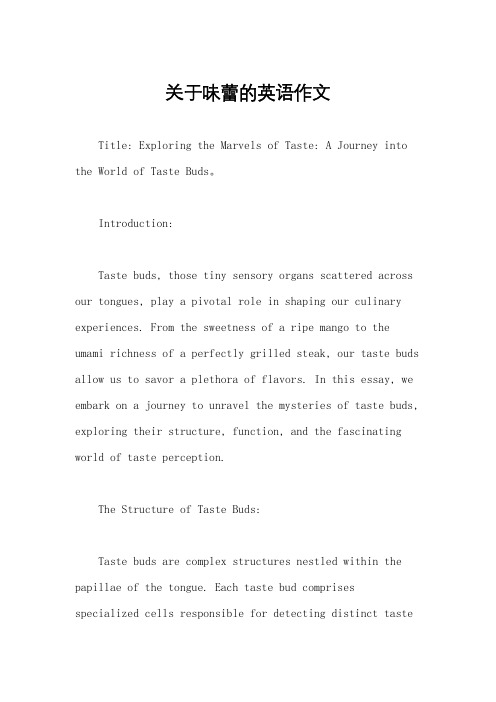
关于味蕾的英语作文Title: Exploring the Marvels of Taste: A Journey into the World of Taste Buds。
Introduction:Taste buds, those tiny sensory organs scattered across our tongues, play a pivotal role in shaping our culinary experiences. From the sweetness of a ripe mango to the umami richness of a perfectly grilled steak, our taste buds allow us to savor a plethora of flavors. In this essay, we embark on a journey to unravel the mysteries of taste buds, exploring their structure, function, and the fascinating world of taste perception.The Structure of Taste Buds:Taste buds are complex structures nestled within the papillae of the tongue. Each taste bud comprises specialized cells responsible for detecting distinct tastequalities: sweet, sour, salty, bitter, and umami. Additionally, recent research suggests the existence oftaste receptors for other flavors like fat and metallic tastes.Function of Taste Buds:When we consume food or beverages, molecules from the substances stimulate the taste receptors within the taste buds. These receptors then send signals to the brain, which interprets the signals as specific tastes. Interestingly, taste perception is not solely determined by the taste buds; factors such as aroma, texture, temperature, and even our cultural background influence how we perceive flavors.The Five Primary Tastes:1. Sweetness: Sweet taste is typically associated with sugars and denotes energy-rich foods. It is perceived atthe tip of the tongue, where taste buds are most sensitiveto sweetness.2. Sourness: Sour taste is often indicative of acidity in foods and is perceived along the sides of the tongue. Sourness adds a tangy, refreshing quality to foods like citrus fruits and yogurt.3. Saltiness: Saltiness enhances flavor and is detected primarily at the sides of the tongue. While essential for our bodies in moderation, excessive salt intake can lead to health issues such as hypertension.4. Bitterness: Bitter taste is perceived at the back of the tongue and is often associated with potentially toxic substances. However, many nutritious foods, such as leafy greens, contain bitter compounds beneficial for health.5. Umami: Umami, translated from Japanese as "pleasant savory taste," is detected towards the back of the tongue. It is attributed to the presence of glutamate, an amino acid found in foods like tomatoes, mushrooms, and aged cheeses.Taste Perception and Individual Variations:Despite the presence of these five primary tastes, taste perception varies among individuals. Genetic factors, age, gender, and even exposure to different flavors during childhood can influence taste preferences. For example, some individuals possess heightened sensitivity to bitter tastes, while others may have a preference for sweet or savory flavors.Cultural Influence on Taste:Our cultural background significantly shapes our culinary preferences and taste experiences. Foods considered delicacies in one culture may be perceived as unpalatable in another. For instance, while Western cuisines often emphasize sweet and savory flavors, Asian cuisines frequently incorporate a balance of sweet, sour, salty, and umami tastes.The Role of Taste in Food Enjoyment:Taste not only serves as a mechanism for identifyingnutrients and potential toxins but also contributes to the pleasure derived from eating. The intricate interplay of flavors, textures, and aromas in a dish can evoke a spectrum of sensory experiences, enhancing our enjoyment of food.Conclusion:In conclusion, taste buds serve as our gateway to the rich tapestry of flavors that define our culinary experiences. Through their remarkable ability to discern various tastes, taste buds enable us to savor the diverse array of foods that enrich our lives. As we continue to explore the complexities of taste perception, let us celebrate the marvels of taste and embrace the cultural diversity that flavors our world.。
李华给家人做饭的作文英语
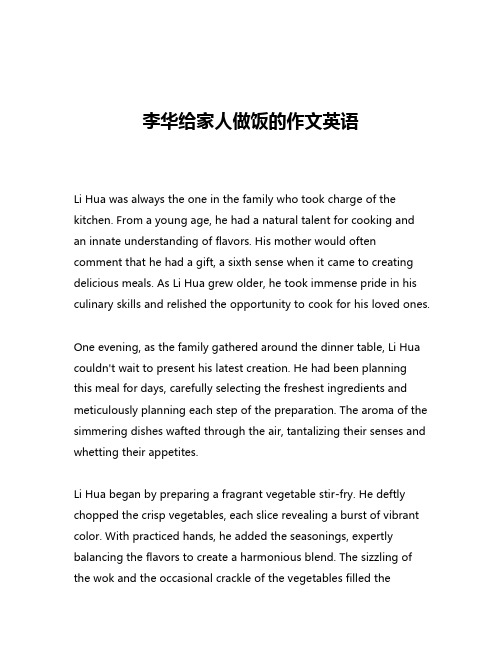
李华给家人做饭的作文英语Li Hua was always the one in the family who took charge of the kitchen. From a young age, he had a natural talent for cooking and an innate understanding of flavors. His mother would often comment that he had a gift, a sixth sense when it came to creating delicious meals. As Li Hua grew older, he took immense pride in his culinary skills and relished the opportunity to cook for his loved ones.One evening, as the family gathered around the dinner table, Li Hua couldn't wait to present his latest creation. He had been planning this meal for days, carefully selecting the freshest ingredients and meticulously planning each step of the preparation. The aroma of the simmering dishes wafted through the air, tantalizing their senses and whetting their appetites.Li Hua began by preparing a fragrant vegetable stir-fry. He deftly chopped the crisp vegetables, each slice revealing a burst of vibrant color. With practiced hands, he added the seasonings, expertly balancing the flavors to create a harmonious blend. The sizzling of the wok and the occasional crackle of the vegetables filled thekitchen, creating a symphony of culinary delight.Next, Li Hua turned his attention to the main course – a succulent braised pork belly dish. He had marinated the meat for hours, allowing the flavors to permeate every fiber. As he gently lowered the chunks of pork into the simmering liquid, the family watched in anticipation, their mouths already watering. The rich, savory aroma promised a truly indulgent experience.Alongside the pork, Li Hua had prepared a steaming pot of fragrant white rice. He knew that the perfect accompaniment to the bold flavors of the braised pork would be the clean, comforting taste of the rice. He had meticulously measured the water-to-rice ratio, ensuring that each grain would be cooked to perfection – fluffy, tender, and infused with the essence of the dish.As the final touch, Li Hua carefully arranged a selection of pickled vegetables on the table. The tangy, crunchy pickles would provide a refreshing contrast to the richness of the other dishes, cleansing the palate and enhancing the overall dining experience.When the table was set and the dishes were ready, Li Hua called his family to gather. The anticipation was palpable as they took their seats, eagerly awaiting the first bite. Li Hua watched with pride as his family savored each morsel, their expressions shifting from delight topure satisfaction.His mother, the family's resident food critic, was the first to speak. "Li Hua, this is simply exquisite," she said, her eyes shining with pride. "The balance of flavors is impeccable, and the textures are absolutely divine. You've outdone yourself once again."Li Hua's father nodded in agreement, his mouth still full of the succulent pork. "This is truly a masterpiece, son. You've managed to capture the essence of our family's favorite dishes and elevate them to new heights."The rest of the family chimed in with their own accolades, each bite eliciting a chorus of delighted exclamations. Li Hua beamed with joy, his heart swelling with a sense of accomplishment and the knowledge that he had brought his loved ones immense pleasure through his culinary talents.As the meal progressed, the conversation flowed effortlessly, punctuated by the sounds of satisfied sighs and the occasional request for seconds. Li Hua basked in the warmth and camaraderie of the moment, savoring the connection that had been forged through the shared experience of a truly remarkable meal.When the plates were finally cleared and the last grain of rice hadbeen savored, Li Hua's family gathered around him, showering him with hugs and heartfelt expressions of gratitude. They knew that his culinary skills were not just a hobby, but a true passion that he poured his heart and soul into.Li Hua's mother, with a twinkle in her eye, said, "Son, you've truly outdone yourself this time. I think it's time we start planning the menu for your wedding!" The family erupted in laughter, and Li Hua couldn't help but feel a surge of pride and excitement at the prospect of sharing his culinary talents with an even larger circle of loved ones.As the evening drew to a close, Li Hua couldn't help but reflect on the joy and satisfaction he had experienced in cooking for his family. It was more than just a means of sustenance; it was an expression of his love, his creativity, and his desire to bring happiness to those he cared about the most. In that moment, Li Hua knew that his passion for cooking would continue to be a driving force in his life, a gift that he would cherish and share for years to come.。
英语作文这才是美味1000字
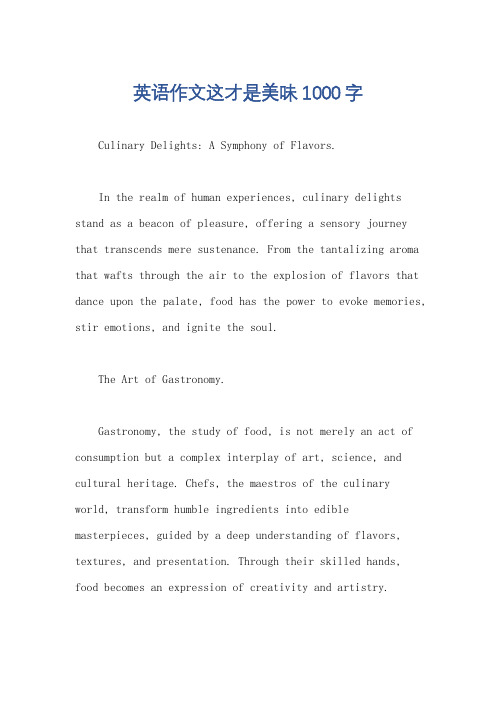
英语作文这才是美味1000字Culinary Delights: A Symphony of Flavors.In the realm of human experiences, culinary delights stand as a beacon of pleasure, offering a sensory journey that transcends mere sustenance. From the tantalizing aroma that wafts through the air to the explosion of flavors that dance upon the palate, food has the power to evoke memories, stir emotions, and ignite the soul.The Art of Gastronomy.Gastronomy, the study of food, is not merely an act of consumption but a complex interplay of art, science, and cultural heritage. Chefs, the maestros of the culinary world, transform humble ingredients into edible masterpieces, guided by a deep understanding of flavors, textures, and presentation. Through their skilled hands, food becomes an expression of creativity and artistry.A Symphony of Flavors.The human palate is an intricate instrument capable of detecting a vast array of tastes. From the sweetness ofripe fruit to the savory tang of fermented foods, each flavor plays a distinct role in the symphony of culinary delights. Sweetness provides a comforting warmth, while saltiness enhances savory flavors. Acidity adds a refreshing brightness, and bitterness brings a touch of complexity. Umami, the fifth taste, often described as "savory" or "meaty," rounds out the spectrum of flavors, creating a harmonious balance.The Dance of Textures.Texture is an essential element in the culinary experience. The crunch of a crispy apple, the smoothness of a velvety sauce, or the chewy resistance of a succulent steak all contribute to the overall enjoyment of food. Contrasting textures, such as the crispy exterior and tender interior of a perfectly roasted chicken, provide a delightful interplay that engages the senses.The Role of Presentation.Presentation, too, plays a crucial role in enhancing the culinary experience. A carefully arranged plate not only pleases the eye but also enhances the anticipation of the flavors to come. The colors, shapes, and textures of food can evoke memories, stimulate the appetite, and create a sense of occasion.Food and Culture.Food is inextricably linked to culture, reflecting the history, traditions, and beliefs of a society. From the humble street food of Southeast Asia to the elaborate feasts of European royalty, culinary practices vary widely around the world. Food becomes a medium through which different cultures can connect, share their stories, and celebrate their unique identities.Health and Nutrition.While culinary delights can bring immense pleasure, itis essential to recognize the importance of balance and moderation. Food should not only satisfy the taste buds but also nourish the body. A balanced diet, rich in fruits, vegetables, whole grains, and lean proteins, provides the essential nutrients that support overall well-being.The Culinary Journey.Embarking on a culinary journey is a lifelong adventure. It involves exploring new cuisines, experimenting with flavors and textures, and discovering hidden gems. Alongthis journey, we learn about different cultures, expand our palates, and cultivate a deeper appreciation for the art of food.Conclusion.Culinary delights are more than just sustenance; they are a celebration of life that enriches our senses,connects us to others, and nourishes our bodies and souls. From the simplest of ingredients to the most elaborate offeasts, food has the power to transform ordinary moments into extraordinary experiences.。
用五感英语作文
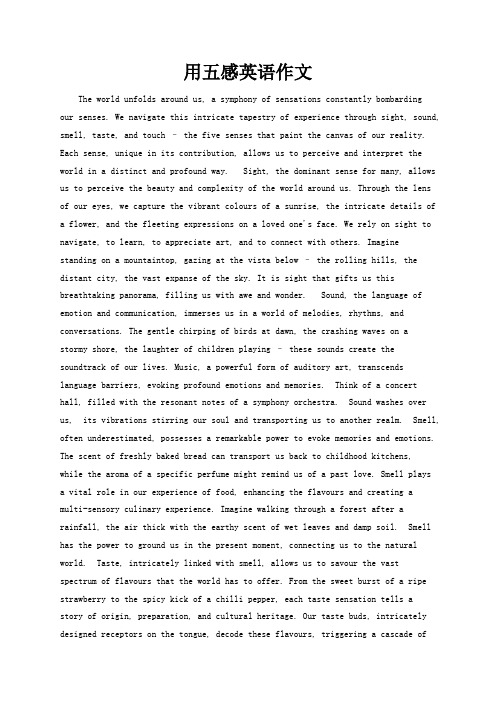
用五感英语作文The world unfolds around us, a symphony of sensations constantly bombardingour senses. We navigate this intricate tapestry of experience through sight, sound, smell, taste, and touch – the five senses that paint the canvas of our reality. Each sense, unique in its contribution, allows us to perceive and interpret the world in a distinct and profound way. Sight, the dominant sense for many, allows us to perceive the beauty and complexity of the world around us. Through the lens of our eyes, we capture the vibrant colours of a sunrise, the intricate details of a flower, and the fleeting expressions on a loved one's face. We rely on sight to navigate, to learn, to appreciate art, and to connect with others. Imaginestanding on a mountaintop, gazing at the vista below – the rolling hills, the distant city, the vast expanse of the sky. It is sight that gifts us this breathtaking panorama, filling us with awe and wonder. Sound, the language of emotion and communication, immerses us in a world of melodies, rhythms, and conversations. The gentle chirping of birds at dawn, the crashing waves on astormy shore, the laughter of children playing – these sounds create the soundtrack of our lives. Music, a powerful form of auditory art, transcends language barriers, evoking profound emotions and memories. Think of a concert hall, filled with the resonant notes of a symphony orchestra. Sound washes over us, its vibrations stirring our soul and transporting us to another realm. Smell, often underestimated, possesses a remarkable power to evoke memories and emotions. The scent of freshly baked bread can transport us back to childhood kitchens,while the aroma of a specific perfume might remind us of a past love. Smell playsa vital role in our experience of food, enhancing the flavours and creating amulti-sensory culinary experience. Imagine walking through a forest after a rainfall, the air thick with the earthy scent of wet leaves and damp soil. Smell has the power to ground us in the present moment, connecting us to the natural world. Taste, intricately linked with smell, allows us to savour the vast spectrum of flavours that the world has to offer. From the sweet burst of a ripe strawberry to the spicy kick of a chilli pepper, each taste sensation tells astory of origin, preparation, and cultural heritage. Our taste buds, intricately designed receptors on the tongue, decode these flavours, triggering a cascade ofreactions that contribute to our enjoyment and nourishment. Consider the simple act of sipping a cup of coffee. The bitterness of the coffee, the subtle sweetness of added sugar, the creamy texture of milk – these elements combine to create a symphony of taste that stimulates our senses and provides a moment of quiet pleasure. Touch, the most primal of our senses, connects us to the physical world in a tangible way. Through the nerves in our skin, we experience the softness of a feather, the roughness of tree bark, the warmth of a loved one's embrace. Touch allows us to explore textures, temperatures, and shapes, providing vital information about our surroundings. Think of holding a newborn baby, the delicate weight in your arms, the softness of their skin against yours. Touch creates a powerful bond, conveying comfort, love, and security. The five senses are not isolated entities but rather work in concert, weaving a tapestry of experiencethat defines our reality. A delicious meal engages not only our sense of taste but also our sight, smell, and even touch as we savour the texture of the food. A walk in nature becomes a multi-sensory symphony, engaging our sight with stunning scenery, our ears with birdsong, our nose with the fragrance of wildflowers, and our skin with the gentle caress of the wind. In a world increasingly dominated by digital stimulation, it's easy to become desensitized to the richness of our sensory experience. By consciously engaging with our five senses, we can cultivate a deeper appreciation for the world around us. Taking the time to truly see the beauty in our surroundings, to listen attentively to the soundscape, to savour the flavours of our food, to inhale the scents of nature, and to feel the textures of our environment can enrich our lives immeasurably. It is through the symphony of our senses that we truly come alive to the wonder and beauty of the world we inhabit.。
美食步骤英文作文
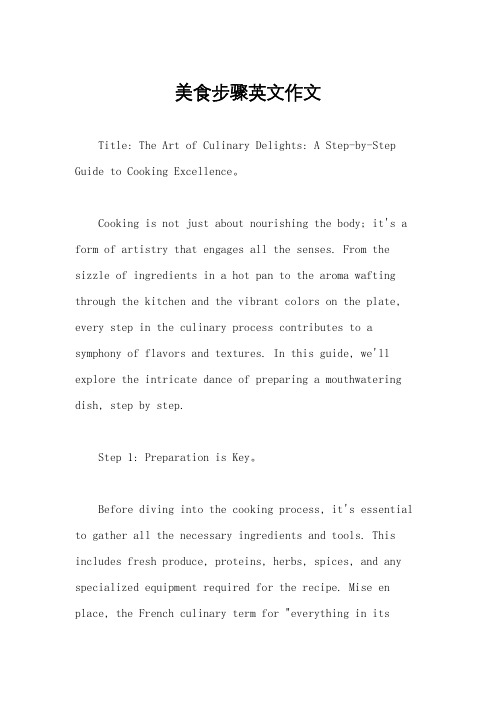
美食步骤英文作文Title: The Art of Culinary Delights: A Step-by-Step Guide to Cooking Excellence。
Cooking is not just about nourishing the body; it's a form of artistry that engages all the senses. From the sizzle of ingredients in a hot pan to the aroma wafting through the kitchen and the vibrant colors on the plate, every step in the culinary process contributes to a symphony of flavors and textures. In this guide, we'll explore the intricate dance of preparing a mouthwatering dish, step by step.Step 1: Preparation is Key。
Before diving into the cooking process, it's essential to gather all the necessary ingredients and tools. This includes fresh produce, proteins, herbs, spices, and any specialized equipment required for the recipe. Mise en place, the French culinary term for "everything in itsplace," is crucial for a smooth cooking experience. Chop, dice, and measure out ingredients beforehand to streamline the cooking process and prevent any last-minute scrambling.Step 2: The Foundation –Sautéing。
- 1、下载文档前请自行甄别文档内容的完整性,平台不提供额外的编辑、内容补充、找答案等附加服务。
- 2、"仅部分预览"的文档,不可在线预览部分如存在完整性等问题,可反馈申请退款(可完整预览的文档不适用该条件!)。
- 3、如文档侵犯您的权益,请联系客服反馈,我们会尽快为您处理(人工客服工作时间:9:00-18:30)。
A Whatare your favorite foods Do you like pizza, hamburgers, roast pork, or sweet cakes and cookies Chances are that, whatever you like best, it has a strong taste and a salty, sweet or savory flavor. People generally like to eat tasty foods, and this can create potential health problems, especially with the consumption of fast or processed food. Fast food traditionally contain a lot of salt or sugar, because this is a cheap way to make food taste good and it encourages people to buy more cookies, chips and soft drinks, for example. However, people are becoming increasingly aware of the dangers of an unhealthy diet, and the manufacturers of processed food know that sales will increase if they can advertise that their products have less salt or sugar. They also know that if their product tastes bland or boring, no amount of health benefits will make it a popular choice with consumers, and they will lose money if their product is not popular. However, a new technologyis currently being developed that may allow fast food manufacturers to reduce salt and sugar without sacrificing taste.
D However, a new technology is being developed that may be an improvement on artificial sweeteners and other chemicals. Taste enhancers target the taste receptors on our tongues and they make us more sensitive to sweet, sour or salty tastes. Just a few molecules of a taste enhancer could double the sweetness effect of a teaspoon of sugar, or the salty effect of a teaspoonof salt. This means that instead of using artificial chemicals to make food tasty, food manufacturers could use half the quantity of the real substance and a tiny quantity of taste enhancer to make the food taste good. This has the potential to save food manufacturers money, by replacing large quantities of sugar and salt with tiny amounts of chemicals. It could also benefit our health if we can eat food that tastes good and is low in sugar and salt.
C The food that we eat contains natural chemicals that fit into the different shaped receptors on our tongues; for example, sweet foods trigger the sweet receptors. The technology to mimic, or copy, these natural flavors with chemicals such as aspartame is a common ingredient in many diet soft drinks and otherdiet products. While aspartame allows us to experience a sweet taste without eating sugar, it also has disadvantages. Firstly, many people do not like its bitter aftertaste, and secondly, some people say that it is bad for health if taken in large quantities.
B If you stick out your tongue and look in the mirror, you will see that it is covered with tiny bumps. These bumps are called taste buds and they are the receptors in your skin that allow us to taste different kinds of foods. There are five different taste receptors, for sweet, salty, sour, bitter and savory flavors. When we are born we have a lot of these on the roof of our mouth as well as on our tongue, but as we get older, we lose taste buds, which is why older people find it harder to taste things. Adults typically have about 10,000 taste buds, but older people may have as few as 5,000. We have more receptors for bitter tastes than for any others; researchers think that this may be because these taste buds warn us if food is poisonous.
